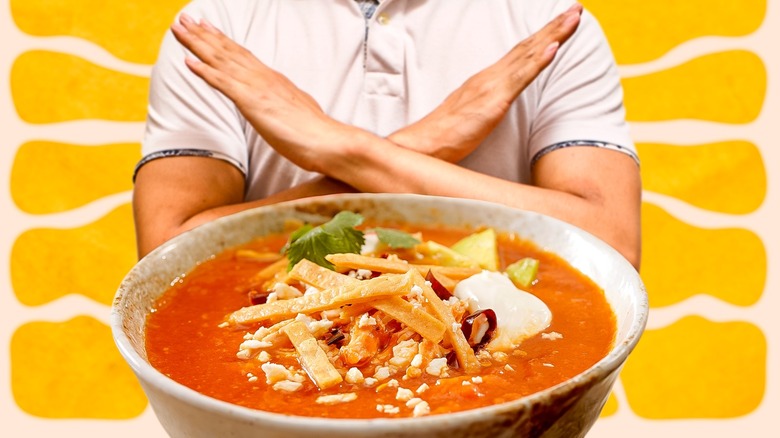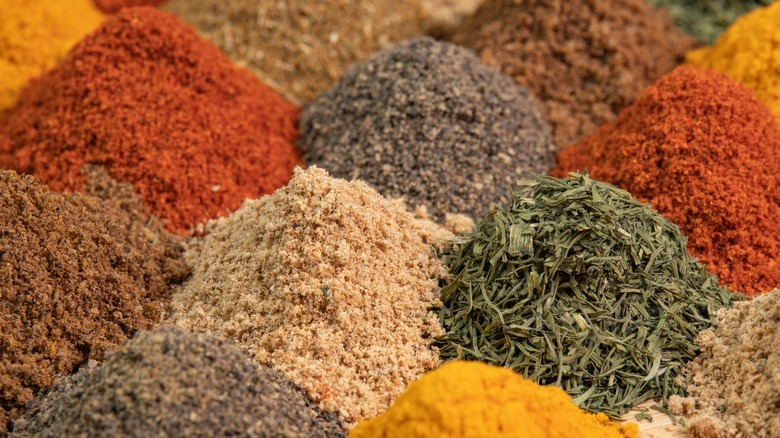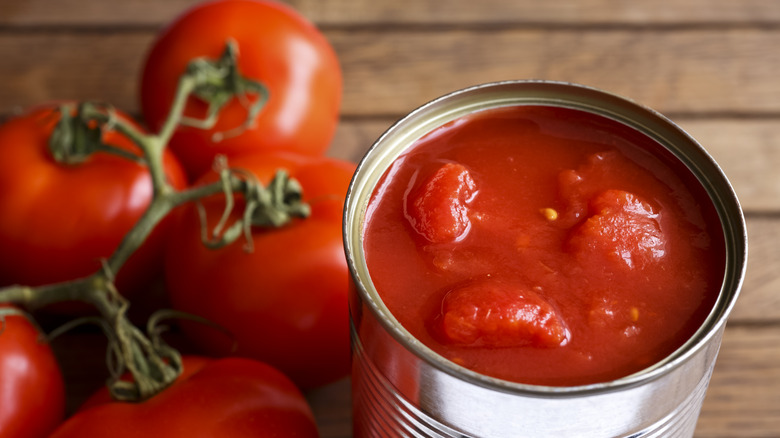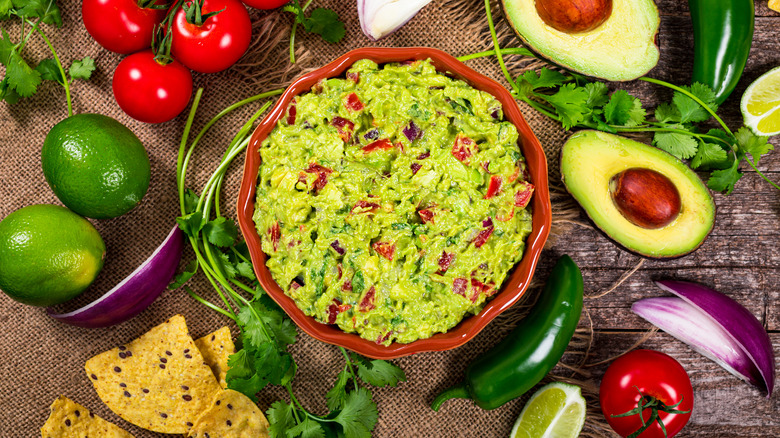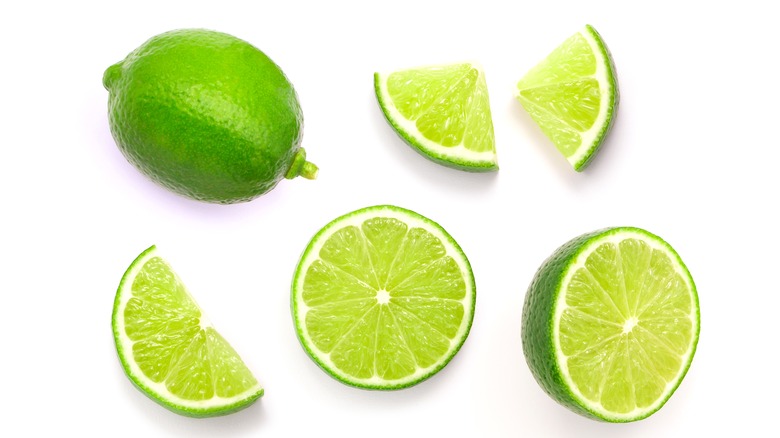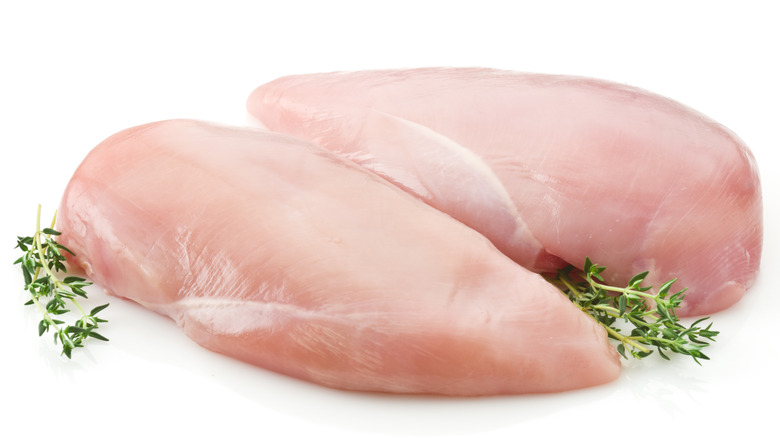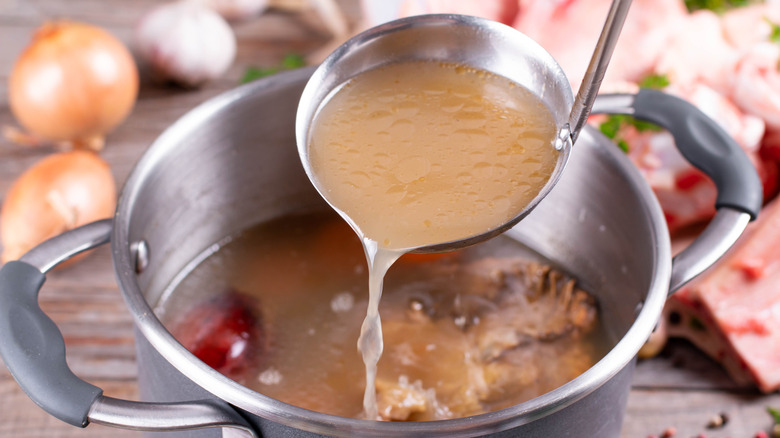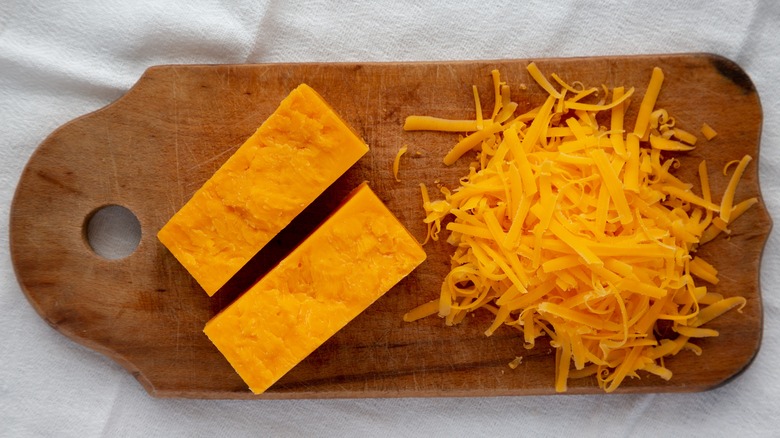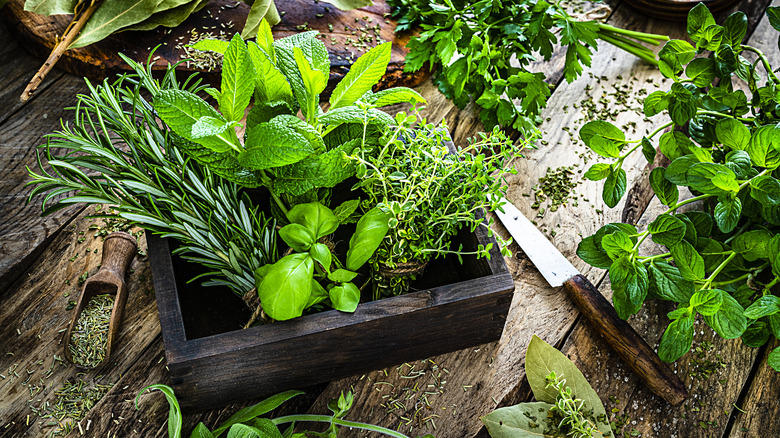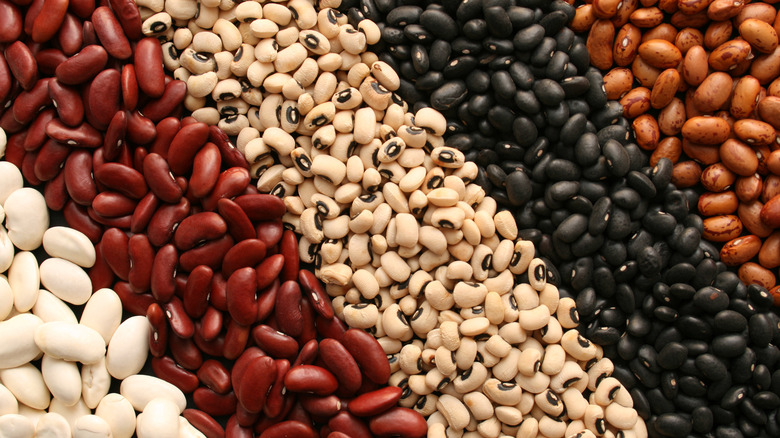12 Mistakes Everybody Makes With Chicken Tortilla Soup
Chicken tortilla soup is hearty, comforting, and packed with flavor. Whether you make it in a slow cooker, a pressure cooker, or just in a big old pot on the stovetop, it is a simple soup to prepare with mostly pantry staples and plenty of ways to customize it.
To create the best version possible of this soup, don't treat it like a plain chicken soup with a sprinkle of spices and crispy tortilla topping. To make tortilla soup come out just right means you need to pay attention to the essential elements of the soup, both the ingredients and the cooking method. The key aspects to focus on are the chicken, the broth, spices, chiles, tomato, tortillas, and an abundant assortment of toppings per bowl. You'll find variations among the recipes, such as fresh tomatoes versus canned or dried whole chiles versus ground chiles, but beyond these minor tweaks, there are some universal tips to ensure your loaded soup ends up tasting just right and does not fall flat.
Using old spices
The broth in tortilla soup is laced with aromatic spices, but to get the most from these spices, they need to be fresh. Over time, spices lose their vibrancy in color and flavor, making it necessary to add more of them to impart the expected flavor. But there is only so much you can add before the texture of the broth is affected. And too much risks the possibility of the soup becoming pasty, dusty, or bitter.
To ensure your spices are flavorful and pungent, there are several helpful tips on spices to keep in mind. First, consider how long the spice has been open. Some brands have a freshness date. If not, use a permanent marker or label maker to record the date opened. Second, consider the kind and quantity of spices you're buying. According to spice company McCormick, whole spices can last up to four years while ground spices will last two to three years. If you don't cook frequently or want to try a new-to-you spice, consider buying the whole version if it is available, or look for a smaller jar.
McCormick also suggests keeping moisture out of the containers to ensure spices stay in their prime. Always use a dry spoon to measure if dipping into the jar, and avoid sprinkling directly from the jar over a steaming pot. The moisture and heat coming from the pot can more quickly dull the flavor and cause the spice to clump and not stay free-flowing.
Adding too much tomato
While the broth in tortilla soup often has a rich red color, it is due to the spices or chiles in the soup combined with some tomato and not because it is a tomato-based broth. Tomatoes are an important element of the soup as they add acidity and umami, but too much will throw the balance off. Chicken tortilla soup can be made with fresh or canned tomatoes, but heavy, concentrated tomato paste should be avoided.
Fresh tomatoes are blended until smooth before being added to the pot so the broth does not have chunks of tomato. You want a light tomato flavor. Charring or roasting them first adds an extra layer of flavor. Canned tomatoes offer more options. Anything from tomato sauce to crushed tomatoes to diced tomatoes can be used. Diced tomatoes can be plain, fire-roasted, or even flavored with garlic. If choosing a smooth product, like sauce or crushed tomatoes, consider how much you are adding so the flavor does not dominate the spices.
Forgetting or botching the fried tortilla strips
It wouldn't be tortilla soup without tortillas. The crispy fried tortilla strips that crown this soup are more than a garnish or an afterthought — their texture and taste make tortilla soup what it is. For the best strips, start with corn tortillas. The choice of white or yellow corn is negligible, but flour tortillas are too heavy for this soup and won't contribute the rich corn flavor expected. Store-bought corn tortilla chips are a shortcut in a pinch, but as with any shortcut, they don't deliver the full experience.
For the best strips, stack a few tortillas, and slice them into even-sized pieces. Many of the same practices as frying homemade tortilla chips apply here. Make sure your frying oil is at the right temperature. If the temperature is too low, the tortillas will absorb the oil and taste greasy. If it's too hot, the chips will burn before you can get them out of the pot. Fry in batches to avoid overcrowding, so each strip ends up an even crispy brown. Once the strips come out of the oil, season them with salt so that it sticks to the hot tortillas, and then drain briefly on a rack or paper towels to eliminate any excess oil.
Skimping on the toppings
The toppings for the soup are almost as important as the base. There is no required number of toppings for the soup, but similar to a taco, the various textures and flavors transform a simple base into something outstanding. Tortilla strips are the most important topping (it's in the name after all). A generous handful of the crispy bites should go on first. Some of the strips will absorb the broth while others, on top, keep their crunch so the corn flavor seeps into the soup. They also offer texture.
Beyond the tortillas, the toppings should offer a mix of creamy, spicy, fresh, and aromatic elements. A creamy topping balances the acidity of the lime, tomato, and spices. It could come from dairy, like shredded or crumbled cheese or a drizzle of crema. Sour cream can replace the crema, if necessary. Ripe avocado slices or chunks also offer that creamy note and can be added instead of or with a dairy element.
For something fresh or spicy, try thinly slicing a radish, a jalapeño, or a serrano chile. Raw chopped white or red onion also adds a juicy, savory kick. Finally, fresh herbs boost the aromatic elements of the soup. Fresh cilantro doesn't even need chopping. Whole tender leaves will gently wilt in the steam of the hot soup. Chives, scallions, or even parsley will also offer that bright flavor. Whatever you choose, offer a variety and generous quantity so each bowl can feel loaded.
Forgetting the lime
The sour acidity of lime juice is an essential aspect of tortilla soup. It adds a fresh flavor that complements and brightens the deep spices in the soup, and the acid brings balance to the broth. You need lime juice, you need it squeezed fresh, and you need a lot of it.
Using the juice from a fresh lime is very different than bottled juice, and it makes a difference in any lime-forward recipe, from bar cookies to cocktails to savory dishes like this soup. Bottled lime juice comes from a concentrate and has a preservative added, often a sulfite, in order to extend the shelf-life. These factors change the taste, and although the lime juice is still sour, it has a heavy cooked flavor. Fresh lime juice is added at the end of the process for this soup to avoid cooking it and changing the flavor too much. Fresh lime wedges are also offered on the side, so people can add one final fresh squeeze to their bowl as they mix in their toppings.
Using pre-cooked chicken
There are so many great uses for pre-cooked chicken, which offers tasty and fast shortcuts at mealtime. But choosing already cooked chicken for this soup is missing out on a major way to flavor and fortify your soup while possibly also compromising on the texture. When raw chicken simmers in the broth, it adds flavor to the soup as it cooks while also absorbing seasoning. It enhances the broth already in the pot to deepen the chicken flavor of the overall soup. Rather than feeling like a soup with chicken, it is a chicken soup through and through. Using cooked chicken skips over this entire aspect, and a key ingredient — the chicken — becomes nothing more than an addition.
Starting with uncooked chicken also allows you to control how long the chicken cooks and what size and shape it will be. A rotisserie chicken is a gamble if the meat you bring home is juicy and tender or dry and stringy. Either way, it is difficult to remove in similarly sized chunks, leading to unevenly sized shredded chicken that falls apart in the broth. Additionally, simmering the already well-cooked chicken can transform the texture, making it mealy or mushy. Instead, simmer raw chicken whole or diced until perfectly tender. After it's cooked in the broth, shred or dice evenly to the desired size, if necessary. Having only been cooked once to the correct doneness, the chicken will be spot on, both in flavor and texture.
Choosing a less flavorful cut of chicken
Yes, boneless skinless chicken is an easy choice to toss into soup. It takes minimal trimming or preparation, and cutting it up is a cinch. To take your soup to the next level, however, there are better and more flavorful cuts of chicken to choose from.
There is a reason that when you make stock, you use skin-on, bone-in chicken pieces. In addition to the flavor from the meat, the skin adds richness, and the bones add flavor and collagen, which adds body to the broth. So, for the best broth and juiciest chicken, opt for bone-in, skin-on cuts of chicken. Dark meat is less likely to overcook and become dry, but since drumsticks don't have a ton of meat, thighs or whole legs (the thigh and leg still attached) are the best choices. If you prefer white meat, buy split bone-in, skin-on chicken breasts. Regardless of the cut, simmer until the meat is no longer pink by the bone, and then let it cool slightly before pulling off the skin, discarding the bones, and shredding or cutting the meat.
Using too little seasoning
The flavor of this soup is bold and robust, with some tingling heat, but it is not intended to blow out your taste buds. When soup tastes bland, it can be tricky to know what to add. Reaching for something spicy without much distinct flavor, like cayenne, will result in a bland and spicy broth. Earthy spices like cumin and coriander are aromatic but not spicy. Chili powder is a blend that skews more flavorful than spicy, especially if you craft your own. These can be used generously at the beginning of the recipe as flavor-building blocks. They can also be used as a finishing seasoning in the last few minutes of cooking to freshen the flavor of the spice, which softens during cooking. If using dried chiles, note the varied heat and flavor of different chiles, and consider a combination to get the best of both.
Salt is also important, but it needs to be added gradually throughout the cooking process for a balanced broth. Salting the vegetables while they cook flavors them and helps them release their liquid. Salt the chicken before adding to the broth to jump-start flavoring it, but hold back adding salt when you pour in the broth. The broth will reduce and concentrate as it cooks, so the final seasoning should happen when the soup is done simmering.
Adding water instead of broth
There are plenty of soups where water can stand in for broth or stock without missing a beat, but chicken tortilla soup is not one of them. Homemade stock is always going to be more flavorful and have a silkier, richer texture than store-bought versions. It is not hard to make, especially if you keep certain tips in mind, like starting with cold water, but store-bought broth is a fine alternative and certainly more convenient if your freezer is empty.
If buying a container of broth, opt for one with low or no sodium. While salt is needed to season the soup, it's optimal to add it yourself and limit unnecessary extra sodium from prepared products. Concentrated soup base or bullion mixed with water can also be used, but be careful with how much you add as it is potent. As the soup simmers and reduces, the flavor and sodium of the base will concentrate, so look for a neutral-flavored base so the spices in the recipe you add are the main flavors you taste.
Buying pre-shredded cheese
The continuous theme among many of these tips to create the best chicken tortilla soup centers around doing a little extra work versus grabbing the more convenient prepared product. The theme extends to the cheese topping for the soup as well.
Whether choosing a creamy, melty cheese or a drier, sharper, crumbled option, like cotija, either option benefits from starting with a chunk of cheese. There are differences between pre-grated and freshly grated cheese that can affect the flavor and performance. When cheese is pre-grated or crumbled, it starts to lose moisture and flavor. Additionally, something is usually added to the container to keep the cheese from clumping together, but that same ingredient keeps the cheese from melting or softening to creamy, luscious perfection. Many pre-crumbled cheeses come in incredibly small pieces or a blend of large chunks and tiny dust-like bits. Starting with a piece means you can crumble it into small bite-sized chunks that top the soup in an ideal ratio of cheese to soup rather than filling your bowl with too much pebble-sized cheese.
Not using fresh herbs
The bright, zingy, and aromatic pop you get from fresh herbs is irreplaceable. The floral, almost limey, flavor of fresh cilantro is essential to this soup. Its dried counterpart only offers some green specks and a mild grassy flavor that is far from fresh tasting. If you shy away from fresh herbs because they don't last in your refrigerator, there are some easy ways to extend their life so you always have them on hand.
Using fresh herbs also allows you to use all parts of the herb to impart different flavor notes. Tender herbs, like cilantro, have juicy edible stems that can be chopped up and sautéed with other ingredients as part of the soup base. Just trim the bottom tough ends off before chopping and cooking. The stems are not as delicate as the leaves, so you can cook them longer without the flavor disappearing. The leaves can be chopped and stirred into the soup to disperse flavor throughout and used whole as an attractive topping choice.
If you can't tolerate the flavor of cilantro (it's okay, it's genetic), you can still boost this soup with fresh herbs. Epazote is an herb with similarities to oregano, and it is often used in this soup. If you can't find epazote, a small amount of fresh oregano will boost the flavor and complement the soup's other spices. Instead of topping the soup with fresh cilantro leaves, try sliced or chopped scallion, chives, or fresh parsley.
Choosing the wrong bean
Beans are often included in tortilla soup as a hearty ingredient that complements the chicken and flavors in the broth. They are meant to be one small component, so choosing the wrong bean can throw off the balance and lead to subpar soup. Cooking dry beans from scratch does take time, but it's very easy and hands-off, and you end up with perfectly tender, not overly mushy, and flavorful beans.
Canned beans are a fine alternative. Rinse and drain them well before adding to the soup. The liquid in canned beans is starchy, and this is not a soup that needs the thickening quality of it or the extra bean flavor. Whether dry or canned, stick to creamy small beans. Black beans, small white beans, or pinto beans are all great options. Large or firm beans, like chickpeas or butter beans, will be out of place and either offer the wrong texture or take up too much space in the bowl.
